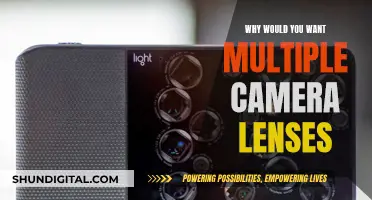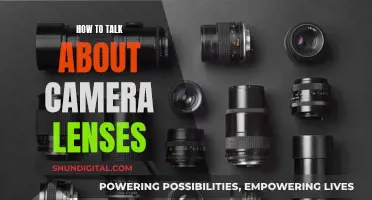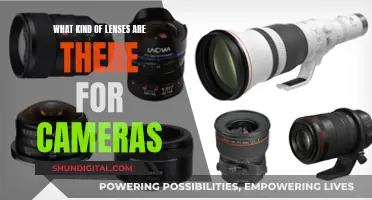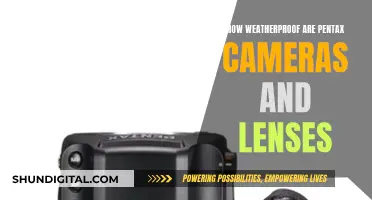
Camera lenses come in a variety of sizes and types, each serving a different purpose. The lens is what focuses light from what you see through the viewfinder into a tiny, typically 35mm spot on the back of your film, DSLR, or mirrorless camera. The lens directs the light and determines how much light passes through, which is partly done through the aperture setting. Different lens types have wider or narrower fields of view, meaning you see more or less of the scene in front of you. The glass elements direct the light to a single point in front of the camera sensor or film, which is called the focal point. The focal length is the distance between the focal point and the sensor. A shorter focal length gives a wider angle of view, while a higher number gives a narrower angle of view but greater magnification.
There are two umbrella categories for lenses: prime and zoom. A prime lens has a fixed focal length and tends to be lighter and cheaper, while a zoom lens has a variable focal length within a particular range and tends to be more versatile and expensive.
| Characteristics | Values |
|---|---|
| Purpose | To focus light from the viewfinder onto the camera's film, DSLR, or mirrorless sensor |
| Image | Without a lens, the only image a camera can produce is white light |
| Focal length | Determines the angle of view and how much the subject is magnified |
| Zoom lenses | Variable focal length within a pre-defined range |
| Prime lenses | Fixed focal length |
| Zoom lenses advantage | More compositions or perspectives without needing to change position |
| Prime lenses advantage | Often have a wider maximum aperture, are cheaper, and lighter |
| Zoom lenses disadvantage | Usually more expensive, heavier, and have smaller maximum apertures |
| Prime lenses disadvantage | Less versatile, need to be changed more often |
| Aperture | Amount the lens can open up or close down to let in more or less light |
| Aperture range | The amount a lens can open up or close down to let in light |
| Maximum aperture | The most important lens aperture specification |
| Minimum aperture | Rarely used due to photo blurring from lens diffraction |

Zoom vs prime lenses
Zoom lenses and prime lenses are two types of detachable camera lenses used by photographers. Zoom lenses have variable focal lengths, allowing photographers to zoom in and out, while prime lenses have a fixed focal length, meaning that the photographer must move physically closer or further from their subject to change how much of it is in the frame.
Zoom Lenses
Zoom lenses are incredibly versatile and are one of the most common types of lenses used in photography. They are perfect for capturing anything from street photography to wildlife. The most popular zoom lens is the 70-200mm lens, often used by wedding photographers. Zoom lenses are also great for travelling light as they can have a large range, such as an 18-270mm lens, allowing photographers to capture both close-up and distant shots without needing to carry multiple lenses.
Zoom lenses are also convenient for photographers who need to handle a variety of situations and are limited to a particular spot. For example, landscape and wildlife photographers who cannot move around freely will benefit from the flexibility of a zoom lens.
Prime Lenses
Prime lenses are classic lenses that have been around as long as cameras have. They are finely tuned to deliver on one specific type of photography, unlike zoom lenses which cater to multiple scenarios. Prime lenses produce much higher-quality images than zoom lenses but are best used by photographers who know exactly when to use them. For example, a 50mm prime lens, also known as the "Nifty Fifty", is perfect for portraits as the focal length is as close to the human eye as possible. A 35mm prime lens, on the other hand, is often used by landscape photographers.
Prime lenses are also generally more compact, offer superior image quality, and are cheaper than zoom lenses. They are smaller and lighter than zoom lenses, making them extremely useful for low-light shooting or blurred-background portraiture where a large maximum aperture is advantageous.
The choice between a zoom and a prime lens depends on the photographer's needs and preferences. Zoom lenses offer the convenience of multiple focal lengths in one lens, making them versatile and easy to use. On the other hand, prime lenses provide superior image quality, a larger maximum aperture, and better low-light performance. They are also more affordable and force photographers to be more deliberate in their composition, encouraging creativity.
In conclusion, both zoom and prime lenses have their advantages and disadvantages, and the best choice depends on the specific requirements and creative vision of the photographer.
Is Your Camera Lens Cracked? Here's How to Tell
You may want to see also

Wide-angle lenses
Some popular wide-angle lenses include:
- Canon RF 24mm F/1.8 Macro IS STM
- Nikon NIKKOR Z 20mm F/1.8 S
- Sony E 20mm F/2.8 SEL20F28
Microscopic Dust: A Camera Lens Issue?
You may want to see also

Telephoto lenses
There are three subtypes of telephoto lenses: short or portrait (85–135 mm), medium (135–300 mm), and super (over 300 mm).
When choosing a telephoto lens, it is important to consider factors such as focal length, aperture, image stabilization, format, and lens mount.
Detecting Radioactivity in Camera Lenses: A Guide
You may want to see also

Macro lenses
When choosing a macro lens, it is important to consider your physical requirements, preferred subject matter, and style. While image quality is important, macro lenses, even on the lower end of the price spectrum, tend to offer professional-level sharpness. However, more expensive lenses often provide better sharpness and produce better bokeh, which is important for certain types of macro photography. Additionally, cheaper lenses may have issues with chromatic aberration.
Some popular macro lenses include the Nikon 60mm f/2.8D, the Canon EF-S 60mm f/2.8 USM, the Canon RF 35mm f/1.8 IS, the Nikon 40mm f/2.8G, the Tamron 90mm f/2.8, the Canon RF 85mm f/2, the Canon EF 100mm f/2.8 USM, the Sigma 105mm f/2.8 Macro, the Nikon 105mm f/2.8G VR, the Canon 100mm f/2.8L IS, the Canon RF 100mm f/2.8L IS, the Sony 90mm f/2.8, the Sigma 150mm f/2.8, the Irix 150mm f/2.8 Macro, the Nikon 200mm f/4, and the Canon 180mm f/3.5L.
Understanding Camera Lenses: Converging or Diverging?
You may want to see also

Standard lenses
At higher focal lengths, such as 85mm or 100mm, standard lenses are ideal for portraiture. When coupled with a wide aperture, they thoroughly soften any background detail, thus making it less likely to distract from the main subject. This is why the 50mm prime lens is also known as the "Nifty Fifty" and is a popular choice among photographers.
Understanding Camera Lenses: A Beginner's Guide to Photography
You may want to see also







